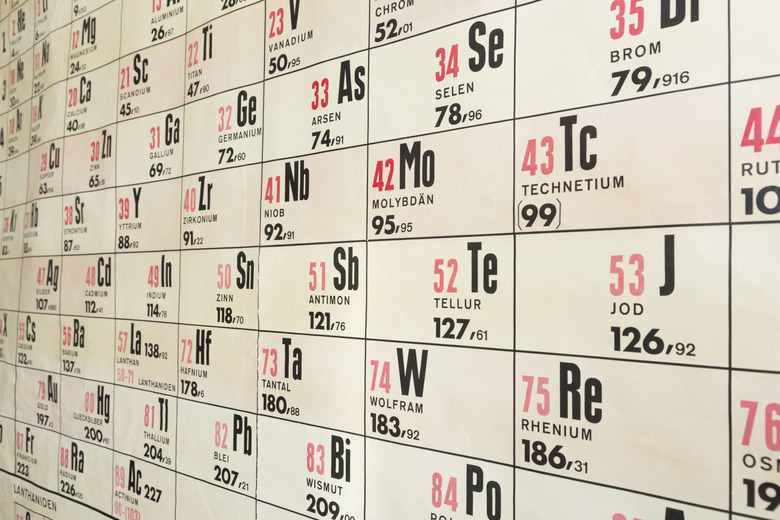The Locations Of Protons, Neutrons And Electrons Within An Atomic Structure
You can compare the structure of an atom to the solar system, where the electrons orbit the nucleus in a manner roughly similar to the planets orbiting the sun. The sun is the heaviest thing in the solar system, and the nucleus holds most of the atom's mass. In the solar system, gravity keeps the planets in their orbits; electricity and other forces hold the atom together.
Nucleus
Nucleus
The nucleus of an atom is its central body, holding particles called protons and neutrons. The number of protons in the nucleus is the atomic number of the element; for example, a helium atom always has two protons, and carbon always has six. Different numbers of neutrons for the same element make atomic "cousins" called isotopes. Most hydrogen atoms, for example, have no neutrons, but a rare few have one and fewer still have two. A special force scientists call the "Strong Force" holds protons and neutrons together inside the nucleus.
Protons
Protons
Protons are the only positively charged subatomic particles in an atom. Its electrical charge is 1.6022 * 10^-19 coulomb — the same as an electron's, although an electron's charge is negative. The proton's mass, 1.67 * 10^-27 kilograms, is very close that of a neutron, and is around 1,837 times heavier than an electron.
Electrons
Electrons
Electrons, usually represented by the symbol "e," are the only negatively-charged particles found in an atom. The mass of an electron is 1.1 * 10^-31 kg. Electrons are grouped in distinct "shells" located outside the nucleus; each shell holds a limited number of electrons, and the number depends on the type of shell. The electron shells are relatively far from the nucleus, making the atom more than 99 percent empty space.
Neutrons
Neutrons
Neutrons, which have no electric charge, reside inside the nucleus along with the protons. All elements have at least one neutron with the exception of hydrogen. The mass of a neutron is 1.6749 * 10^-27 kg. Some radioactive elements, such as uranium, eject some of their neutrons; when this happens, the neutron wanders for an average of about 15 minutes outside of the atom before it disintegrates into a proton and an electron.
References
- Boston University: Electric charge and Coulomb's law
- Penny Press Ltd.; Neutron; 2010
- Georgia State University: Radioactive Decay Constant
Cite This Article
MLA
Tripathi, Neha. "The Locations Of Protons, Neutrons And Electrons Within An Atomic Structure" sciencing.com, https://www.sciencing.com/locations-electrons-within-atomic-structure-8608032/. 24 April 2017.
APA
Tripathi, Neha. (2017, April 24). The Locations Of Protons, Neutrons And Electrons Within An Atomic Structure. sciencing.com. Retrieved from https://www.sciencing.com/locations-electrons-within-atomic-structure-8608032/
Chicago
Tripathi, Neha. The Locations Of Protons, Neutrons And Electrons Within An Atomic Structure last modified March 24, 2022. https://www.sciencing.com/locations-electrons-within-atomic-structure-8608032/
